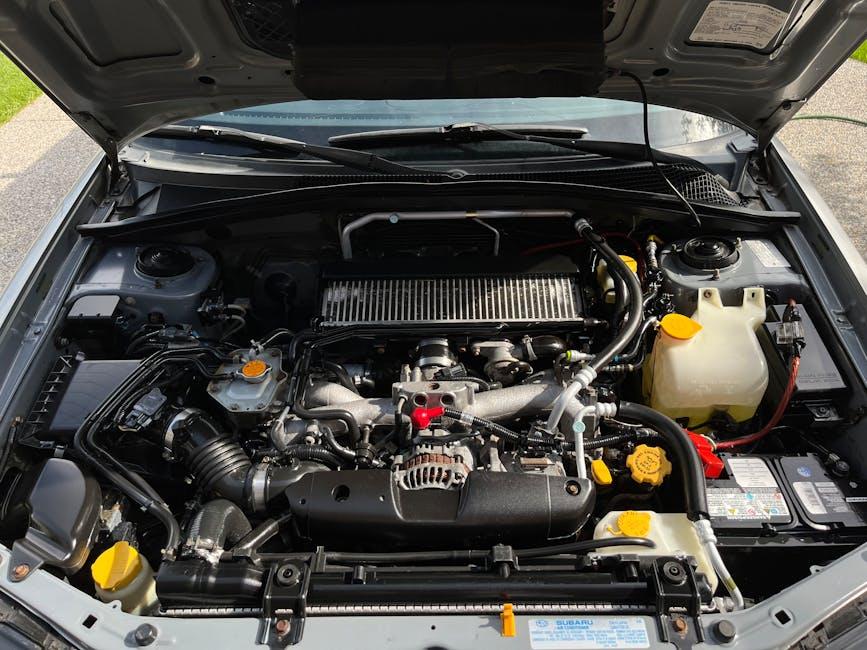Your car’s alternator is much like the unsung hero of your vehicle’s electrical system—quietly working behind the scenes to keep the battery charged and all your electronic components running smoothly. But when that steady hum turns into silence, or your dashboard starts flickering like a dim movie theater, it’s a sign your alternator may be struggling. Knowing how to test your car’s alternator is an essential skill that can save you from unexpected breakdowns and costly repairs. In this article, we’ll guide you step-by-step through the process of diagnosing alternator health, empowering you to keep your car’s electrical heart beating strong.
Table of Contents
- Recognizing the Signs of a Failing Alternator
- Essential Tools You’ll Need for Testing Your Alternator
- Step-by-Step Guide to Conducting a Basic Voltage Test
- Interpreting Your Test Results with Confidence
- Advanced Diagnostic Methods for Persistent Issues
- When to Consult a Professional Mechanic for Alternator Repairs
- Q&A
- The Conclusion

Recognizing the Signs of a Failing Alternator
When your alternator starts to falter, it often sends out subtle signals before your car eventually breaks down. Among the most common clues are dim headlights or flickering dashboard lights, which indicate inconsistent electrical output. You might also experience strange noises, such as grinding or whining sounds, caused by worn-out alternator bearings. If your vehicle’s electrical components, like the radio or power windows, behave erratically, it’s time to take a closer look under the hood. Another telltale sign is a dead battery, not necessarily because the battery itself is faulty, but because the alternator isn’t charging it properly while the engine is running.
Keep an eye out for these symptoms which often appear in combination:
- Engine stalling or difficulty starting
- Warning light indicators on the dashboard, such as the battery icon
- Burning rubber or electrical smells
- Low or inconsistent voltmeter readings
Addressing these warning signs early on can save you from being stranded and avoid costly repairs down the line. Familiarize yourself with these symptoms so you can confidently decide when it’s time to test your alternator’s health or seek professional help.

Essential Tools You’ll Need for Testing Your Alternator
Before diving into the testing process, gather a few crucial instruments to ensure an accurate and safe diagnosis. A reliable digital multimeter is indispensable—it accurately measures voltage, current, and resistance, allowing you to check if the alternator is producing the right output. Additionally, having a set of insulated gloves and safety glasses is essential for protecting yourself from electrical hazards while working under the hood. For more hands-on checks, a voltage tester helps identify if power is reaching the alternator, and a basic socket set makes it easier to access the components without damaging any parts.
Here’s a handy list of tools to keep within arm’s reach:
- Digital Multimeter
- Voltage Tester
- Insulated Gloves
- Safety Glasses
- Socket Set
- Battery Terminal Cleaner (optional, but useful for cleaner contacts)
| Tool | Purpose |
|---|---|
| Digital Multimeter | Measure alternator output voltage and battery voltage |
| Voltage Tester | Check for power flow without detailed readings |
| Socket Set | Remove alternator or related parts if needed |
| Insulated Gloves | Protect hands from electrical shocks |

Step-by-Step Guide to Conducting a Basic Voltage Test
Begin by ensuring your vehicle is parked in a safe, well-lit area with the engine turned off. Locate the alternator and its battery terminals—you’ll want your multimeter in hand with the voltage setting adjusted to 20V DC for accuracy. Before touching any components, wear insulated gloves and safety glasses to protect yourself. Next, connect the black (negative) lead of the multimeter to the battery’s negative terminal or a clean, unpainted metal surface on the car’s frame. Then, gently touch the red (positive) lead to the battery’s positive terminal. This setup prepares you for an accurate voltage reading without damaging your equipment or vehicle.
Start the engine and observe the voltage reading on your multimeter. A healthy alternator typically produces between 13.8V and 14.8V under operating conditions. If the meter shows a voltage below 13.5V or above 15V, this might signal an alternator problem or voltage regulator issues. Here’s a quick reference table to help identify your alternator’s condition based on voltage:
| Voltage Reading | Condition |
|---|---|
| 13.8V – 14.8V | Healthy Alternator |
| < 13.5V | Undercharging – Possible Fault |
| > 15.0V | Overcharging – Check Voltage Regulator |
For a more thorough check, test the voltage at different engine speeds such as idle and slightly revved RPMs. Keep in mind these essential tips:
- Double-check connections: Loose or corroded battery terminals can skew your readings.
- Avoid contact: Never touch moving engine parts while testing.
- Use proper tools: Always use an accurate multimeter designed for automotive testing.

Interpreting Your Test Results with Confidence
After taking your multimeter readings or completing a voltmeter test, it’s crucial to understand what those numbers actually mean for the health of your alternator. Typically, a healthy alternator should produce a voltage between 13.8 and 14.8 volts when the engine is running. If your readings fall below this range, it might indicate that the alternator is not supplying enough power, which could lead to a battery draining problem. Conversely, voltages exceeding 15 volts suggest an overcharging condition, which can damage your battery and electrical components over time.
Keep these quick tips in mind as you interpret your measurements:
- Consistency is key: Run multiple tests to ensure stability in your readings.
- Understand context: Electrical loads like headlights or HVAC systems can affect voltage readings, so test with different accessories on and off.
- Note engine speed: Voltage should stabilize around idle RPM and not fluctuate wildly when you rev the engine.
| Voltage Level | Condition Indicated | Suggested Action |
|---|---|---|
| Below 13.8 V | Undercharging alternator | Inspect alternator belt, wiring, or replace alternator |
| 13.8 V – 14.8 V | Normal operation | No action needed |
| Above 15 V | Overcharging alternator | Check voltage regulator or alternator replacement |

Advanced Diagnostic Methods for Persistent Issues
When your alternator issue persists after basic tests, it’s time to dive deeper with sophisticated diagnostic techniques. Start by conducting a load test using a multimeter and a load tester or by observing voltage drop under different electrical demands. Connect the multimeter across the battery terminals and switch on multiple high-consumption devices like headlights, air conditioning, and the rear defroster. A healthy alternator should maintain a voltage between 13.8 to 14.5 volts. If the voltage dips significantly, it signals the alternator may not be keeping up with the electrical load, indicating internal faults or worn components.
Another advanced approach incorporates checking the diode trio and voltage regulator circuit. Using an oscilloscope or specialized tester, observe the alternator’s ripple voltage — a smooth DC output points to well-functioning diodes, while irregular fluctuations suggest diode failures. Additionally, the alternator’s internal grounds and connections should be inspected for corrosion or loose terminals that can cause intermittent failures without triggering error codes. Below is a quick reference table to interpret common voltage and ripple waveforms during tests:
| Test Type | Expected Reading | Possible Issue |
|---|---|---|
| Voltage under load | 13.8 – 14.5 V | Normal alternator function |
| Voltage under load | < 13.5 V | Weak alternator output |
| Ripple voltage (oscilloscope) | Minimal/steady DC | Good diode condition |
| Ripple voltage (oscilloscope) | Excessive ripple spikes | Faulty diodes |

When to Consult a Professional Mechanic for Alternator Repairs
While many alternator issues can be diagnosed and even repaired with basic tools, certain symptoms indicate it’s time to seek expert assistance. If your vehicle’s electrical system is behaving erratically despite simple tests showing inconsistent results, or if the battery warning light remains stubbornly illuminated after multiple checks, these are clear signs that professional diagnostics are necessary. Attempting to fix complex alternator malfunctions without the right experience can lead to further damage or unsafe driving conditions.
Knowing when to hand over the reins can save you time, money, and frustration. Consider consulting a mechanic if you notice:
- Unusual noises such as grinding or whining coming from under the hood
- Frequent battery replacements that don’t seem to solve your charging issues
- Dim or flickering headlights despite your alternator tests showing borderline results
- Intermittent electrical failures affecting key components like the radio or power windows
Professionals possess advanced tools to pinpoint alternator faults accurately and can advise whether repair or full replacement is the best course of action, ensuring your car’s reliability and safety on the road.
| Symptom | What It Means | Recommended Action |
|---|---|---|
| Persistent Battery Warning Light | Possible faulty alternator or battery issue | Schedule professional diagnostic test |
| Whining Noise from Engine | Worn bearings or loose alternator belt | Immediate mechanic inspection advised |
| Electrical Accessories Malfunction | Irregular voltage output from alternator | Consult professional for alternator testing |
Q&A
Q&A: How to Test Your Car’s Alternator
Q1: What is the alternator, and why is it important?
A1: The alternator is like your car’s electrical heart—it generates power to keep your battery charged and runs accessories like headlights, radio, and air conditioning. Without a healthy alternator, your car can stall or fail to start.
Q2: How can I tell if my alternator might be failing?
A2: Warning signs include dimming lights, a dead battery, strange noises, or dashboard warning lights (especially the battery icon). These clues often mean the alternator isn’t charging properly.
Q3: What tools do I need to test my alternator at home?
A3: At minimum, you’ll need a digital multimeter (a handy gadget to measure voltage) and a basic understanding of your car’s battery terminals.
Q4: How do I prepare my car for the alternator test?
A4: Make sure the engine is off and cooled down. Open the hood, locate the battery terminals, and set your multimeter to measure DC voltage.
Q5: What does a baseline battery voltage reading look like?
A5: With the engine off, a healthy, fully charged battery should read about 12.6 volts. Lower than 12.4 could mean your battery is weak or partially drained.
Q6: How do I test the alternator while the car is running?
A6: Start the engine and carefully measure the voltage across the battery terminals again. A properly functioning alternator should push the voltage between roughly 13.8 and 14.8 volts.
Q7: What if the voltage reading is too low or too high?
A7: Voltage below 13.8 volts suggests the alternator isn’t charging enough. A voltage above 15 volts indicates an overcharging problem, which can damage your battery and electronics.
Q8: Can I test the alternator without a multimeter?
A8: Simple tests exist—like turning on the headlights and revving the engine to see if the lights brighten. But these are less reliable than precise voltage measurements.
Q9: When should I visit a mechanic instead of testing myself?
A9: If you spot persistent electrical issues, hear unusual noises like grinding or whining, or if you’re uncomfortable performing tests, it’s best to get a professional diagnosis.
Q10: How often should I test my alternator?
A10: Regular checks during routine maintenance or at the first sign of electrical trouble help avoid unexpected breakdowns. Alternators can last many years but don’t last forever!
The Conclusion
Testing your car’s alternator may seem like a daunting task at first, but with a little know-how and some simple tools, it’s entirely within your reach. By taking the time to check this vital component, you’re not only ensuring your vehicle runs smoothly but also saving yourself from unexpected breakdowns and costly repairs. Remember, your alternator is the heart of your car’s electrical system—keeping it in check means keeping your journey on the road, wherever it may lead. So next time you hear that telltale flicker of your dashboard lights or notice a sluggish battery, you’ll know exactly where to start. Safe driving and happy testing!


2 Comments
3y5t8q
3y5t8q